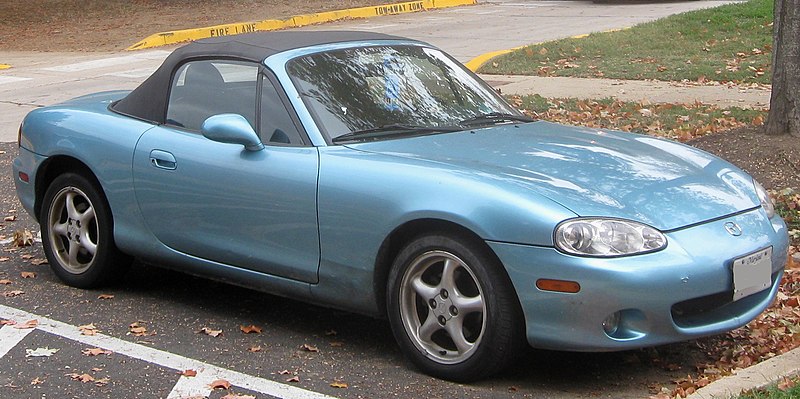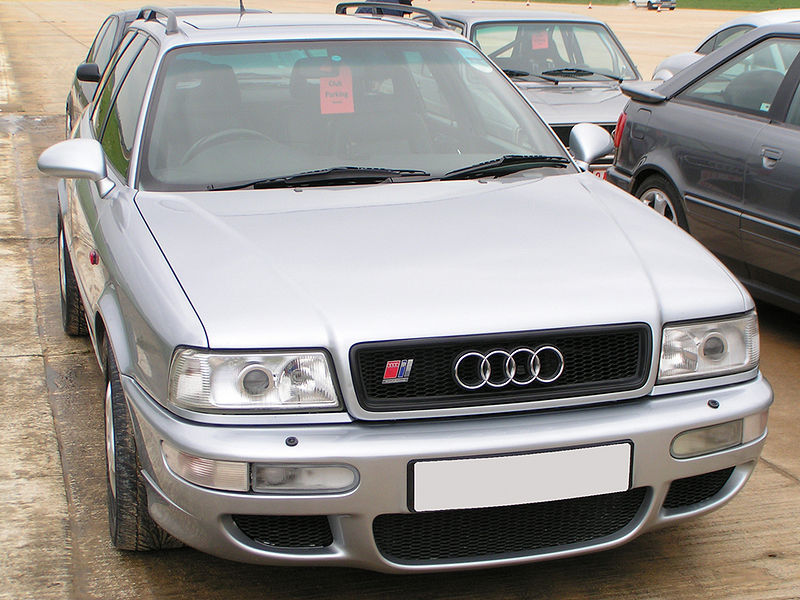The 90s were a golden age for car fans, introducing unforgettable cars like the Toyota Supra, Nissan Skyline GT-R, and Mazda RX-7, alongside supercars like the McLaren F1. This era marked a leap in technology and performance, partly thanks to Japan’s economic boom, which pushed brands like Toyota, Nissan, and Mazda to flex their creative muscles. This led to some of the most iconic sports cars we know today.
Mazda MX-5 Miata (1990)
Launched in 1989 and making its mark throughout the 90s, the Mazda MX-5 Miata redefined what a roadster could be. Today, it’s not only a 90s icon but a timeless classic in the automotive world.
When the Mazda MX-5 Miata hit the roads in 1989, it quickly became a legend, marking itself as one of Mazda’s most successful cars. The Miata of the 90s set the stage for what would become a world-class sports car series. It stood out from the typical sports cars of the time, which were often heavy and costly, by being light, reliable, fun, and affordable.
With its lightweight design, perfect weight distribution, and responsive handling, the Miata offered an unadulterated driving experience. From the precise shift knob to the carefully crafted exhaust notes, it was built for enjoyment, not just speed. The way it leans playfully into corners and the feel of the steering wheel in your hands makes driving it a joyous experience.
Honda NSX (1990)
If you were a fan of the “The Need for Speed” video game in the 90s, chances are you’ve ‘driven’ an Acura NSX. Honda’s foray into high-performance sports cars with the NSX was a resounding success. Released in 1990 and staying largely unchanged until its discontinuation in 2005, the NSX was famous for its durability and reliability.
Under the hood, it had a 3.0-liter V6 engine with 270 horsepower, capable of accelerating from zero to 60 mph in just five seconds, thanks to its lightweight aluminum build. It was the first production car to feature an all-aluminum body, and its design was influenced by the legendary F1 driver Ayrton Senna. The NSX brought supercar performance and aesthetics to a more accessible price point without sacrificing reliability. It was a testament to Honda’s engineering prowess and remains a coveted vehicle among enthusiasts.
The NSX stood out in comparison tests, even outperforming rivals like the Chevy Corvette ZR-1 and Ferrari models. What’s more impressive is that it offered this high performance while maintaining the reliability and ease of use that Honda was known for. It set a new benchmark for all sports and supercars that followed.
Toyota Supra MKIV (1993)
The Toyota Supra MKIV became an icon of the 90s for its striking design and impressive performance capabilities, particularly the Turbo model with its legendary 2JZ-GTE engine. This engine was known for its robustness and tunability, making the Supra a favorite among performance enthusiasts. Its fame was further cemented by its appearances in popular culture, including the “Fast and Furious” film franchise.
This model is legendary for its robust 2JZ straight-six engine and its distinctive rounded styling. The Mk IV Supra has earned its place as one of the greatest cars ever to come out of Japan.
Subaru Impreza Turbo 2000 (1994)
The Impreza Turbo 2000 debuted in 1994, a rebranded version of the Japanese-market Impreza WRX. It came equipped with 208 horsepower and Subaru’s renowned symmetrical four-wheel-drive system. Even in its standard form, this car could accelerate from 0 to 62 mph in 5.5 seconds and reach a top speed of 140 mph. The factory ‘Turbo’ model, introduced in 1999, offered even more power for those looking to up the ante.
For those who grew up watching rallying in the 90s, the Subaru Impreza, especially in its blue-and-yellow livery, is synonymous with the rallying legend Colin McRae. Many argue that there hasn’t been a more visually striking or better-handling Impreza since.
Ford Explorer (1990)
The Ford Explorer, in its first generation, was built on the same platform as the Ford Ranger pickup truck. While not a performance vehicle, the Ford Explorer deserves a mention for its role in popularizing the SUV in America. The Explorer offered a mix of utility, space, and comfort that was previously unseen in the SUV market. It was a vehicle that perfectly fit the suburban family’s needs, signaling the start of the SUV craze that would dominate the automotive landscape for years to come.
Now, over thirty years later and six generations in, the Ford Explorer still holds true to its original purpose: a capable, versatile vehicle that offers comfort for the whole family. As one of the defining cars of the ’90s, the first-gen Explorer is still a great buy.
Dodge Viper (1991)
When the Dodge Viper hit the scene in 1991, it was more than just a car – it sparked a 90s cultural phenomenon, even inspiring its own TV show where it helped fight crime in a fictional California city. Sure, the Viper wasn’t the comfiest ride out there, but it was undeniably cool.
Under the hood, the Viper packed an 8.0-liter V10 engine, delivering 400 horsepower and capable of hitting top speeds of 164 mph. Priced at $52,000, it could hold its own against pricier performance cars. But it was missing some things you might expect, like glass windows, exterior door locks, airbags, air conditioning, and antilock brakes.
Despite its quirks, the Viper became an icon of its time. Dodge stopped making it in 2017 due to falling sales and its struggle to meet modern safety standards, but it remains a symbol of 90s automotive culture.
Audi RS2 (1995)
While the Ur-Quattro was Audi’s first step into modern performance cars, it was the RS2, with its Quattro engine and Porsche’s touch, that really kick-started the RS series. Back then, Audi needed extra expertise for this project, and Porsche was the perfect fit, especially since they were looking for a new venture after their work on the Mercedes 500E.
Starting with the Audi 80 Avant as a base, the car bodies were initially made by Audi and then sent over to Porsche in Zuffenhausen. There, they were fitted with brakes, wheels, and tires from the Porsche 968 Clubsport and, for some reason, wing mirrors from a 964 Turbo. The five-cylinder engine got a major upgrade with a larger turbo, intercooler, and injectors, plus a new camshaft, ramping up its power to 315PS (232kW). This made it one of the most powerful engines in the Volkswagen Group.
The result was astonishing: the Audi RS2 could accelerate to 62 mph in under five seconds and reach 30 mph in just 1.5 seconds, making it quicker off the mark than a McLaren F1.
Ferrari F355 (1994)
The Ferrari F355 was a significant advancement from its predecessor, the 348. With its sculpted lines and improved performance, the F355 represented the epitome of a 90s Ferrari. The introduction of a 5-valve per-cylinder V8 engine, a first for Ferrari, offered increased power and an exhilarating exhaust note, making the F355 one of the most desirable Ferraris of the decade.
If you’re in the market for a Ferrari F355, the one to aim for is the stunning ‘Berlinetta’ coupe. Ideally, you’d want it with a manual gearbox, a right-hand drive, and a well-documented history. This model is often hailed as the most beautiful mid-engined car ever to come out of Maranello. It’s this blend of elegant yet purposeful design and a modern driving experience that makes it so sought-after.
The F355 was Ferrari’s last ‘junior’ mid-engined car with a steel chassis and the first to feature an ‘F1’-style paddle-shift gearbox. Though the paddle-shift versions are reliable and require regular maintenance, the manual models were more common. Collectors especially value the early versions with non-airbag steering wheels and simpler Bosch injection systems. Remember, buying a cheap F355 with a spotty history or cutting corners on maintenance can be risky.
Ford Escort RS Cosworth (1992)
The Ford Escort RS Cosworth was a rally car for the road, famous for its distinctive whale-tail spoiler and aggressive styling. Much like the CLK, the Ford Escort RS Cosworth was a homologation special designed specifically so Ford could race it in the Group A rally category. It features a powerful turbocharged inline-four engine from Cosworth, delivering power to all four wheels.
And, of course, who could overlook its iconic and unmistakable rear wing? Its prowess in the World Rally Championship made it a favorite among motorsport enthusiasts.
BMW 5-Series (1997)
The E39 5-series blended the luxury and technology of BMW’s flagship 7-series but in a more compact and engaging package. Through the lens of 2020, we see a car from a time when technology was enhancing both reliability and comfort. BMW focused on refining essentials rather than reinventing them, influenced by Lexus’s approach to high-class interiors and plush leather seating.
The ride was anything but soft, though. Near-perfect weight distribution ensured balanced handling, and the car’s suspension – a front strut and rear multilink setup – was tuned for both comfort and spirited driving. Despite its use of aluminum in the chassis and engine and some lightweight materials in the structure, the E39 was on the heavier side; the 528i tipped the scales at over 3600 pounds. This heft contributed to a solid feel that is still impressive today.
The E39 earned six 10Best awards from 1997 to 2002, a testament to its excellence. When a new 5-series arrived in 2004, it brought modern design updates but at the cost of some of the soul that made the E39 a standout blend of luxury, design, and performance. The E39 remains one of the greatest of all time in BMW’s history.
Honda Civic (1992)
Honda really hit the mark with the Civic, especially with its fifth-generation model from 1992 to 1995. This version of the Civic solidified its status in the automotive world. It became the ideal choice for those looking for a budget-friendly car with almost endless potential for aftermarket performance upgrades.
Interestingly, many automotive companies used this generation of the Civic as a standard to develop adjustable components. These definitive cars of the 90s are still quite a catch in terms of affordability.
Honda Insight (1999)
While Toyota often gets the credit for launching the first production hybrid car, Honda’s effort, which came just a few years later, was arguably more innovative and interesting. The 1999 Honda Insight stood out for several reasons.
The Insight was powered by a 1.0-liter inline-three engine, which made extensive use of lightweight materials like aluminum, magnesium, and plastic in its construction. This engine alone produced 68PS (50kW), but when combined with an electric motor, its power was boosted to 74PS (54kW). The goal was to emulate the performance of a typical 1.5-liter engine.
But the Insight wasn’t just about power. Its design focused heavily on aerodynamics, boasting a drag coefficient of just 0.25. In fact, up until 2015, Insight held the title of the most fuel-efficient vehicle ever tested by the US Environmental Protection Agency. This makes the 1999 Honda Insight a significant milestone in the history of hybrid vehicles.
Conclusion
The 1990s were a golden age for car enthusiasts, offering a diverse range of vehicles that catered to different tastes and needs. These cars were more than just modes of transportation; they were symbols of the technological advancements and cultural shifts of the time. Whether it was a sports car’s exhilarating drive or an SUV’s practicality, the 90s had something special for everyone. As we look back, it’s clear that the cars of this era weren’t just products of their time – they were timeless classics that continue to influence and inspire the automotive world today.






